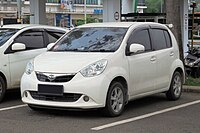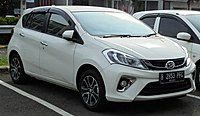
Daihatsu Motor Co., Ltd., commonly known as Daihatsu, is a Japanese automobile manufacturer and one of the oldest surviving Japanese internal combustion engine manufacturers. The company's headquarters are located in Ikeda, Osaka Prefecture.

Perusahaan Otomobil Kedua Sendirian Berhad, usually abbreviated to Perodua, is Malaysia's largest car manufacturer, followed by Proton.

The Daihatsu Boon is a subcompact car produced by Japanese automaker Daihatsu since 2004, and also sold under Toyota brand as the Toyota Passo between 2004 and 2023. The Passo was once sold at Toyota Corolla Store Japanese dealerships until it was consolidated with other Toyota dealers in 2020.
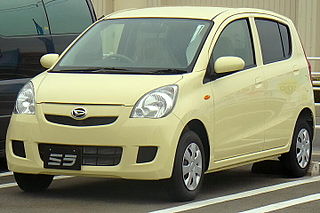
The Daihatsu Mira is a kei car and city car built by Japanese car maker Daihatsu. It has a variety of options and chassis variations, with the latest variant having four models: Mira, Mira AVY, Mira Gino, and Mira VAN. The Mira is the latest successor to the line of cars begun with the Daihatsu Fellow of 1966, and was originally introduced as the commercial version of the Cuore. Outside of Japan, the Mira has also been offered with larger 850 or 1000-cc engines. In Australia, the two-seater version was marketed as the Daihatsu Handivan and later as the Daihatsu Handi. The term mira is Latin meaning "goal" or "purpose".

The Daihatsu Move is a kei car/city car manufactured by the Japanese automaker Daihatsu between August 1995 and June 2023. The Move was Daihatsu's response to the similarly designed Suzuki Wagon R that was introduced two years earlier in 1993. The first Move was designed by Italian design house I.DE.A Institute and succeeding generations continued to build upon the original design. The Move is built upon the chassis of the Mira but with a taller body.

The Daihatsu Terios is a mini SUV produced by the Japanese automobile manufacturer Daihatsu since 1997 as the successor to the F300 series Rocky. It was initially offered in both short- and long-wheelbase configurations before the former stopped production in 2016 to be replaced by the A200 series Rocky crossover in 2019. The long-wheelbase variant is available mainly for the Indonesian market with three-row seating options. A smaller kei car model called the Terios Kid/Lucia was also available for the first-generation model.
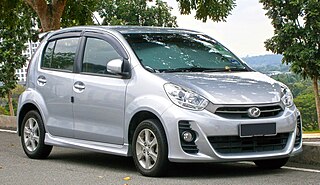
The Perodua Myvi is a subcompact car/supermini (B-segment) produced by the Malaysian manufacturer Perodua since 2005. Based on the Daihatsu Boon, the Myvi is the result of Perodua's collaboration with both Toyota and Daihatsu. However, the third generation Myvi was entirely designed and made in Malaysia, thus not being based on the third generation Boon. The Myvi was the best-selling car in Malaysia for nine consecutive years, between 2006 and 2014, and again between the years 2018 and 2022. The Myvi has been Malaysia's best-selling car for 14 years since its first full year of sales in 2006. As of 2023, the Myvi reached 1.4 million units sold since the launch of its first generation in 2005.

The Perodua Kancil is a city car manufactured by Malaysian automobile manufacturer Perodua from August 1994 to July 2009. The Kancil is a rebadged third generation Daihatsu Mira.

The Toyota Avanza and Daihatsu Xenia are a series of multi-purpose vehicles (MPV) developed by Daihatsu and marketed by both Toyota and Daihatsu, mainly sold with three-row seating. The Avanza and Xenia were developed as an entry-level MPV marketed mainly for the Indonesian and other emerging markets, and mainly produced in Indonesia by Astra Daihatsu Motor. Avanza's spiritual predecessor was the Kijang, whose model program has since been split into two different models to expand Toyota's reach in the MPV sector.

The Toyota KR engine family is a straight-3 piston engine, designed by Daihatsu, a subsidiary of Toyota. The 1KR series uses aluminium engine blocks and chain driven DOHC cylinder heads. It uses multi-point fuel injection, and has 4 valves per cylinder. Some versions have VVT-i variable valve timing. The engine is exceptionally light: 69 kg (152 lb) with all ancillaries.

The Toyota SZ engine family is a series of straight-4 piston engines with a forward-facing exhaust. Toyota Motor Manufacturing (UK) in Deeside produces SZ engines for the Yaris. All three types of the SZ engine are built in Tianjin FAW Toyota Engine Co., Ltd. (TFTE) Plant No. 1 in Xiqing District, Tianjin, China. The 2SZ-FE and 3SZ-FE variations are also manufactured by PT Astra Daihatsu Motor's Karawang Engine Plant in Indonesia.

The Toyota NR engine family is a series of small inline-four piston engines designed and manufactured by Toyota, with capacities between 1.2 and 1.5 litres.

The M500 series Perodua Alza is the first generation of Alza B-segment multi-purpose vehicle (MPV) produced by Malaysian car manufacturer Perodua. Based on the Daihatsu Boon Luminas, it was launched in November 2009 as the company's first purpose-built MPV.

The Daihatsu E-series engine is a range of compact three-cylinder, internal combustion piston engines, designed by Daihatsu, which is a subsidiary of Toyota. The petrol-driven series has cast iron engine blocks and aluminum cylinder heads, and are of either SOHC or DOHC design, with belt driven heads.

The Perodua Axia is a city car produced by Malaysian automobile manufacturer Perodua. It was launched on 15 September 2014 as the successor to the Viva. The car takes over the title of being the most affordable car in Malaysia from the Viva, and the best-selling car in Malaysia for three consecutive years, between 2015 until 2017. The Axia is the first model to debut from Perodua's all-new second factory in Rawang, Selangor. As of mid-2023, the Axia reached 600,000 units sold since the launch of its first generation in 2014.
The automotive industry in Malaysia consists of 27 vehicle producers and over 640 component manufacturers. The Malaysian automotive industry is the third largest in Southeast Asia, and the 23rd largest in the world, with an annual production output of over 500,000 vehicles. The automotive industry contributes 4% or RM 40 billion to Malaysia's GDP, and employs a workforce of over 700,000 throughout a nationwide ecosystem.
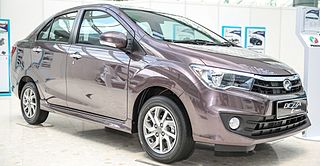
The Perodua Bezza is an A-segment sedan produced by Malaysian automobile manufacturer Perodua. It was launched on 21 July 2016 as Perodua's first sedan car, and a complement to the Axia hatchback.
The Daihatsu New Global Architecture (abbreviated as DNGA) is a modular unibody automobile platform that underpin various Daihatsu vehicles and its rebadged versions supplied for Toyota, Subaru, and Perodua. Introduced in 2019, it is aimed for vehicles built for the Japanese market and overseas emerging markets. Daihatsu has planned to introduce the platform to 21 models and 15 body types with a targeted annual production of 2.5 million vehicles to be sold in 90 countries by 2025. Despite the similar naming, it is not mechanically related to the Toyota New Global Architecture.

The A200/A250 seriesDaihatsu Rocky is a subcompact crossover SUV manufactured by Daihatsu. It was unveiled at the 46th Tokyo Motor Show on 23 October 2019 under the "New Compact SUV" name. It replaced the Be‣go in the Japanese market and went on sale on 5 November 2019. The Rocky is also rebadged and sold under Toyota and Subaru brands as the Toyota Raize and Subaru Rex respectively.

The Perodua Alza is a B-segment multi-purpose vehicle (MPV) produced by Malaysian car manufacturer Perodua. The first-generation model, based on the Daihatsu Boon Luminas, was launched in November 2009 as the company's first purpose-built MPV. The second-generation model that was introduced in 2022 is based on the W100 series Daihatsu Xenia.




